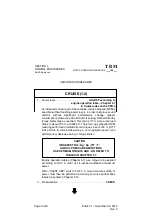
SECTION 4
NORMAL PROCEDURES
EASA Approved
TBM
700
PILOT’S OPERATING HANDBOOK
Page 4.5.1
Edition 1 -- November 30, 2010
Rev. 0
4.5 -- PARTICULAR PROCEDURES
REMARK :
The procedures and procedure elements given in this Chapter
”PARTICULAR PROCEDURES” supplement the normal procedures or
complete certain elements of the normal procedures described in Chapter(s)
4.3 and/or 4.4.
FLIGHT INTO KNOWN ICING CONDITIONS (1/5)
General
1 -- Icing conditions exist when the OAT on the ground or in flight is + 13
°
C
or below, and visible moisture in any form is present (clouds, fog with
visibility of one mile (1.6 km) or less, rain, snow, sleed or ice crystals).
2 -- Icing conditions also exist when the OAT on the ground is + 13
°
C or
below and when operating on ramps, taxiways or runways where
surface snow, ice, standing water or slush may be ingested by the
engine or freeze on engine or cowlings.
NOTE :
Refer to Figure 5.4.1 to convert OAT to SAT in flight.
SAT = OAT -- 2
°
C on the ground.
3 -- Flight into known icing conditions is authorized when all airplane
equipment provided for ice protection is operating correctly. This
includes :
-- Pneumatic deice system for inboard and outboard wing, for
stabilizers and for elevator horns.
-- Propeller electrical deice system.
-- Electrical heating system for both pitots and for the stall warning
incidence sensor.
-- Windshield electrical deice system.
-- Inertial separator.
Description of deice systems is presented in Chapter 7.13.
Ice accumulation thickness is monitored by the pilot on the L.H. wing leading
edge.
At night, a leading edge icing inspection light located on the fuselage
L.H. side, activated by the ”ICE LIGHT” switch, is provided.
















































